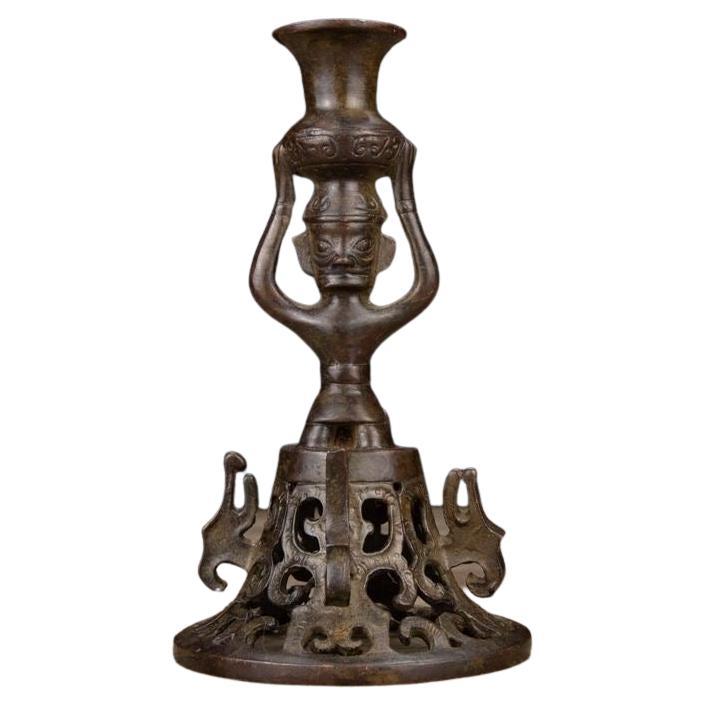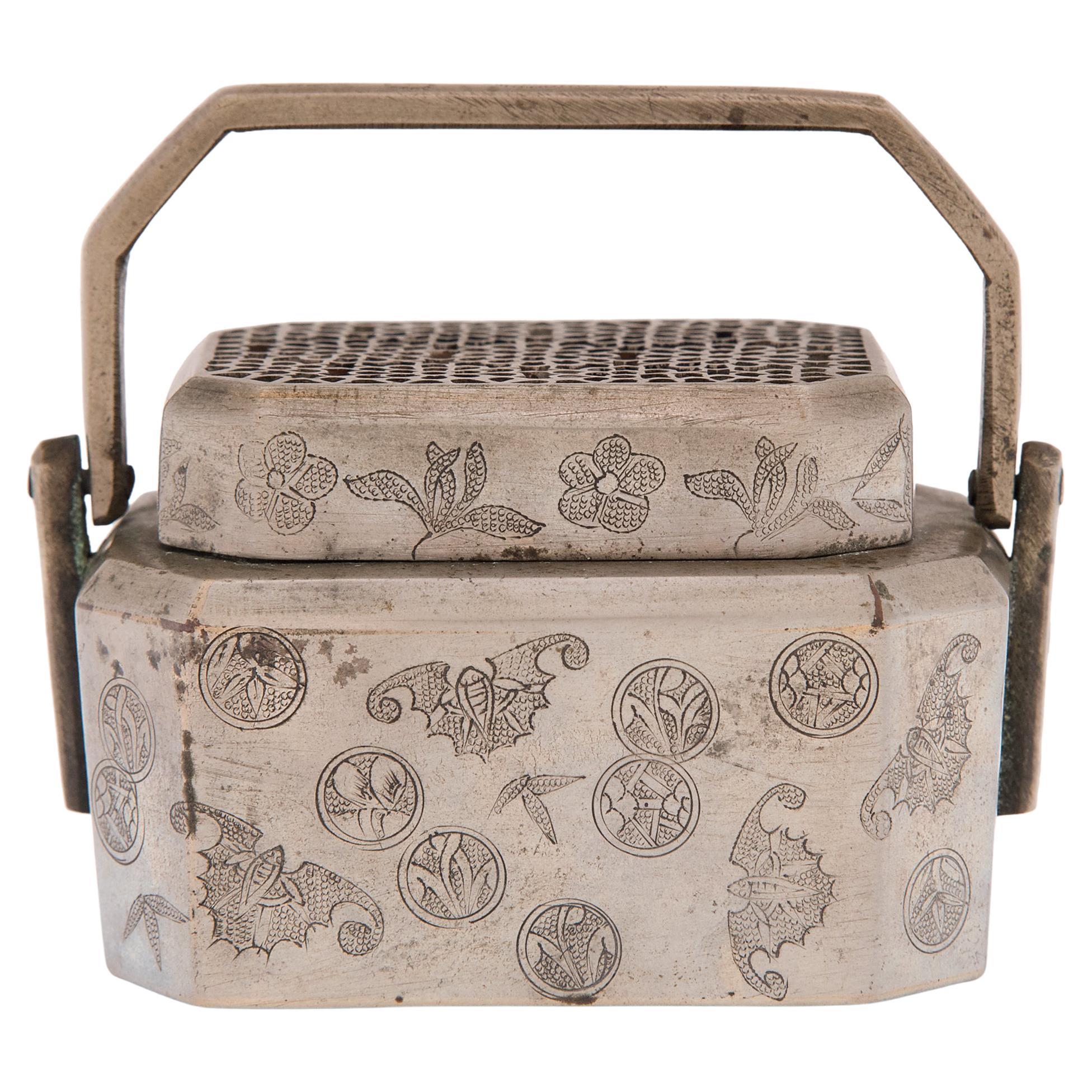Items Similar to Vintage Chinese Double Happiness Wedding Candlesticks
Want more images or videos?
Request additional images or videos from the seller
1 of 10
Vintage Chinese Double Happiness Wedding Candlesticks
About the Item
Presenting a lovely vintage Chinese double happiness wedding candlesticks, a matching pair.
Made in China in the early 20th century of bronzed pewter, with their original folded beehive wax candles.
Made circa 1930.
Made for the purpose of commemorating and celebrating a wedding ceremony.
The candlesticks contain the symbols for love, double happiness and marriage.
Unmarked, but show signs of genuine age.
Double Happiness (simplified Chinese: ??; traditional Chinese: ??; pinyin: shuangxi) sometimes translated as Double Happy, is a Chinese traditional ornament design, commonly used as a decoration symbol of marriage. Outside of China, it is also used in the United States, Europe and Southeast Asia.
- Dimensions:Height: 15.5 in (39.37 cm)Width: 4.5 in (11.43 cm)Depth: 3.25 in (8.26 cm)
- Sold As:Set of 2
- Style:Archaistic (In the Style Of)
- Materials and Techniques:Pewter,Cast
- Place of Origin:
- Period:
- Date of Manufacture:1930
- Condition:Wear consistent with age and use. Very good original condition.
- Seller Location:Dallas, TX
- Reference Number:1stDibs: LU3978121217032
About the Seller
4.9
Platinum Seller
These expertly vetted sellers are 1stDibs' most experienced sellers and are rated highest by our customers.
Established in 2015
1stDibs seller since 2018
349 sales on 1stDibs
Typical response time: <1 hour
- ShippingRetrieving quote...Ships From: Dallas, TX
- Return PolicyA return for this item may be initiated within 7 days of delivery.
More From This SellerView All
- Large Oriental Champleve Cloisonne Urn on StandLocated in Dallas, TXPresenting a beautiful and very high quality large oriental champlevé cloisonné urn on stand. Late 19th or early 20th century, circa 1890-1910. Pro...Category
Early 20th Century Japanese Japonisme Metalwork
MaterialsBrass, Bronze, Enamel
- Japanese Meiji Period Sterling Silver 2 Handled Basket by Katsu MiyamotoBy Miyamoto Shoko 1Located in Dallas, TXPRESENTING a GORGEOUS, VERY HIGH QUALITY and EXTREMELY RARE piece of Japanese Meiji Period Sterling Silver 2 Handled Basket by Katsu Miyamoto. EXQUISITE, EXCEPTIONAL, RARE & IMPORTANT! This is definitely a Meiji Period piece due to the fact that it is marked with the sterling silver mark “jungin”. The Meiji period was from 1868 to 1912 and in 1928 a law was introduced in Japan compelling the use of decimal marks for silver. This pre-dates that decimalization law. We are of the opinion that it is from circa 1900. Miyamoto Shoko was founded in 1880 as the first silverware specialty shop. In 1899, Miyamoto Shoko’s silverwares were ordered by the family members of the Emperor of Japan, and to this day, they are making fine and graceful handicrafts with skillful craftsmen. Loved by numerous customers since the Meiji era, Miyamoto Shoko’s products have also been given to Princess Mako and Princess Kako of Akishino, as well as Princess Aiko Toshinomiya, on their birthdays. Katsu Miyamoto (宮本勝), in 1880, in order to increase the sales of tobacco and cigarettes to foreigners founded the Moyamoto Shoko company, which produced different silverwares in general and particularly silver cigarette cases. Miyamoto’s first name, Katsu (勝) in some sources is written as “Masaru”, since 勝 kanji can be pronounced in both ways. This basket is of the HIGHEST QUALITY imaginable! The top of the basket has the MOST GORGEOUS repousse work of flowers, probably lotus flowers, with leaves and foliage. It has an underlying chevron effect chasing, reflecting parquetry. The 2 handles are cast in the form of bamboo handles. The rim of the top likewise is cast as bamboo. The base is equally stunning in a different way! It is chased with a chevron effect, like parquetry flooring and the four feet simulate pieces of sliced bamboo with an interlinking gallery of support columns, likewise, simulating bamboo. The QUALITY of WORKMANSHIP is OUTSTANDING! The pieces weighs exactly 525 grams. This piece takes my breath away! This is one for the SERIOUS COLLECTOR of EXQUISITE AND RARE Japanese silver. You will not find another like it, for sale ANYWHERE ELSE IN THE WORLD …… I know as I have searched! Provenance: Acquired from a Dallas Private Collector. Dimensions: 9.6 inches wide, 7.6 inches deep and 2.75 inches tall ( 7.25 inches tall with handles up) Condition: Very good. It looks like the base 4 legged gallery, has been repaired/re-attached to the base, but otherwise it is excellent and of Museum quality. The Meiji period (明治時代 Meiji-jidai?), also known as the Meiji era, is a Japanese era which extended from October 23, 1868 through July 30, 1912.[1] This period represents the first half of the Empire of Japan during which Japanese society moved from being an isolated feudal society to its modern form. Fundamental changes affected its social structure, internal politics, economy, military, and foreign relations. The period corresponded with the reign of Emperor Meiji after 1868, and lasted until his death in 1912. It was succeeded by the Taishō period upon the accession of Emperor Taishō to the throne. Solid silver pieces...Category
Early 20th Century Japanese Meiji Metalwork
MaterialsSterling Silver
- Early 20th Century Gilt Metal Thai Khon DancerLocated in Dallas, TXPresenting a beautiful early 20th century Gilt Metal Thai Khon Dancer. Made in Thailand (South East Asia) circa 1920. It features a gilt meta...Category
Early 20th Century Thai Country Sculptures and Carvings
MaterialsMetal
- Antique Indian Dhokra Horse and Rider SculptureLocated in Dallas, TXPresenting a lovely antique Indian Dhokra horse and rider sculpture. Probably from the late 19th or early 20th century as is evidenced by its natural patina and clear evidence of age. It depicts an Indian Warrior with a sword in his right hand mounted on his horse/steed. The warrior is in classical and ancient Southeast Asian Indian attire and he holds the horse’s reins in his left hand. The body of the horse is a series of lines (in the Classic Dhokra Style) and it has a tribal headdress...Category
Antique Late 19th Century Indian Anglo Raj Metalwork
MaterialsMetal
- Japanese Meiji Champleve and Bronze UrnLocated in Dallas, TXPresenting a gorgeous Japanese Meiji Champleve and bronze urn. Made in Japan during the Meiji Period circa 1880. The body of ...Category
Antique Late 19th Century Japanese Meiji Metalwork
MaterialsBronze, Enamel
- Vintage Chinese Green and Brown Serpentine Foo Dog Chop SealLocated in Dallas, TXPresenting a stunning and rare vintage Chinese green and brown serpentine foo dog chop seal, Hong Kong/Chinese, circa 1950s or 1960s A fantastically carved...Category
Mid-20th Century Chinese Meiji Sculptures and Carvings
MaterialsSerpentine
You May Also Like
- Chinese Vintage Old Bronze CandlestickLocated in 景德镇市, CNThis Chinese Vintage Old Bronze Candlestick is a beautiful and historically significant item. Bronze has been a popular material in Chinese art and crafts...Category
Antique 19th Century Metalwork
MaterialsBronze
- Chinese White Brass Happiness Brazier, c. 1850Located in Chicago, ILFilled with burning coals, this petite 19th-century brass brazier once warmed the hands of a well-to-do person on a cold winter's night in northern China. The brazier is crafted of white brass in a rectangular form, complete with a hinged handle and an intricately pierced lid with a chrysanthemum pattern. The exterior is etched with a pattern of golden coins...Category
Antique Mid-19th Century Chinese Qing Metalwork
MaterialsBrass
- Chinese Bronze Dragons Candlesticks Imperial StyleLocated in North Hollywood, CAVery decorative Chinese contemporary large bronze "Dragons" candlesticks; with relief design of dragons chasing pearls. With a straight foot supporting a bell-shaped base surmounted...Category
Mid-20th Century Chinese Chinese Export Metalwork
MaterialsBronze
- Pair of Chinese Export Silver CandlesticksLocated in London, GBPair of Chinese Export silver candlesticks with the character for "Luck" on one and "Longevity" on the other. They are attached to round wood stands. ...Category
Antique 1890s Chinese Chinese Export Metalwork
MaterialsSilver
- Pair of Chinese Export Silver CandlesticksBy Tuck Chang & Co.Located in London, GBA pair of Chinese Export silver candlesticks, marked with TC, for Tuck Chang, 德祥 公记(DeXiangGongJi), a Shanghai retailer from 1901-1934, and with the maker's mark of 培记 (PeiJi). 230gm...Category
Antique Late 19th Century Chinese Chinese Export Metalwork
MaterialsSilver
- Pair of Large Chinese Polished Brass CandlesticksLocated in North Hollywood, CAPair of large vintage Mid-Century Chinoiserie polished gold brass candlesticks with removable Chinese fu dogs on top. Cast brass candle holders.Category
20th Century Chinese Chinese Export Metalwork
MaterialsBrass
Recently Viewed
View AllMore Ways To Browse
Indian And Islamic Art
Bronze Incense Burner
Asian Antiques Cloisonne
Islamic Calligraphy Art
Antique Asian Sword
Antique Asian Swords
Incense Burner Japan
Asian Antique Trays
Japanese Incense Burner
Chinese Censer
Bronze Asian Bowl
Bronze Censer
Islamic Antiques Brass
Japanese Bronze Cranes
Meiji Bronze Birds
Censer Incense
Mughal Metal
Indian Repousse





